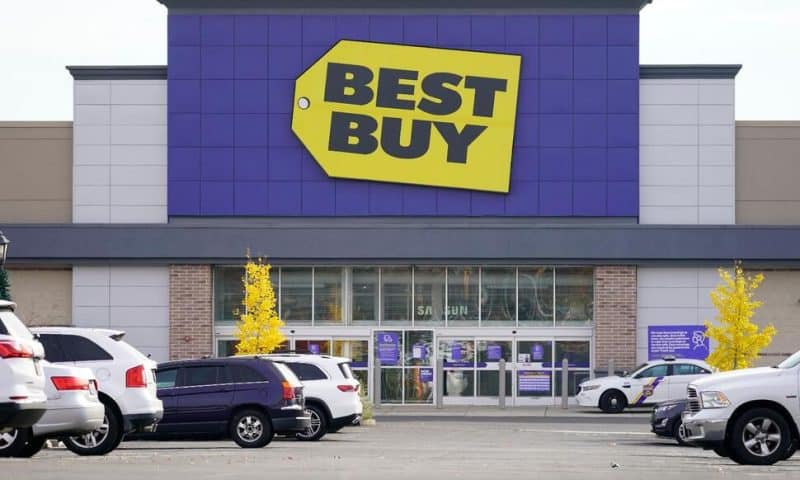The earnings results from Best Buy and Kohl’s, announced Thursday, offer the latest evidence of consumers’ cautious spending amid a challenging economic environment
NEW YORK — The earnings results from Best Buy and Kohl’s, announced Thursday, offer the latest evidence of consumers’ cautious spending amid a challenging economic environment.
Best Buy, the nation’s largest consumer electronics chain, reported another quarterly drop in sales as Americans pull back on gadget spending to prioritize essential purchases and pay more for things like rent.
The company, based in Minneapolis, has reported quarterly sales declines for more than two years, a stretch reaching back to the pandemic when households were bulking up on new laptops and other goods to work from home.
Sales were worse than Wall Street had expected, but profits were better than projected. Best Buy offered a muted forecast for the year. But shares rose more than 11% in morning trading as investors appeared to like how the company is trying to get shoppers to spend again.
Kohl’s reported a loss in the latest quarter and another drop in sales as the various moves to fix its business still haven’t been enough to get shoppers to spend. The department store chain is also facing increasing competition from the likes of discounters and off-price stores like TJ Maxx which offer trendy apparel at affordable prices. The results missed Wall Street expectations, and Kohl’s offered a disappointing outlook. Shares of the retailer dropped close to 25%.
The U.S. job market has remained strong, but Americans are paying more for necessities like rent and groceries even as inflation appears to have begun to cool overall. But Americans are paying more when they use credit cards because interest rates are higher, leading many to put off big ticket purchases like appliances and other goods typically bought using credit. They’re also focusing more on experiences like travel and tickets to concerts.
For Best Buy, that was a reversal of what they saw during the height of the pandemic, when its sales were being fueled by oversized spending from workers splurged on electronics to help them work from home, or to get their children better equipped for virtual learning. Government stimulus checks fueled a lot of that spending as well.
Best Buy plans to modernize stores to entice shoppers and focus on its paid membership services that have resonated with its customers. The company has been also reducing its layers of management and reinvesting in more labor at its stores to help shoppers.
“Customers remained very deal-focused and attracted to more predictable sales moments,” Best Buy CEO Corie Barry told analysts during the call. She said the overall appliance category has been very promotional, but the company has focused on being thoughtful in its deals.
Barry told reporters on a media call on Thursday that Best Buy was also hurt by the pause in innovation as manufacturers were focusing on supply chain issues during the height of the pandemic. But she thinks that new gadgets like the new class of AI-imbued personal computers from the likes of Microsoft, while expensive, are more efficient and offer more battery life that shoppers will value. And those new devices will result in lower prices of the older computers.
Best Buy reported a profit of $246 million, or $1.13 per share, for the quarter ended May 4. That compares with a profit of $244 million, or $1.11 per share, in the year-ago period. Adjusted earnings per share was $1.20, easily topping Wall Street expectations for $1.08, according to a poll by FactSet.
Sales fell to $8.85 billion from $9.46 billion, and were short of the $8.96 billion that industry analysts had expected.
Comparable sales — those from established online and physical store channels — dropped 6.1%.
Best Buy anticipates earnings per share for the year ranging from $5.75 to $6.20 on revenue ranging from $41.3 billion to $42.6 billion. Analysts have been projecting earnings of $6.04 per share on revenue of $41.94 billion.
Kohl’s reported a loss of $27 million, or 24 cents per share, in the quarter ended May 4. That compares with a profit of $14 million, or 13 cents per share, in the year ago period. Analysts were expecting a profit of 5 cents, according to a poll by FactSet.
The company said that sales were down 5.3% to $3.18 billion from $3.36 billion in the year-ago quarter. Analysts were expecting sales of $3.4 billion, according to FactSet.
Comparable sales were down 4.4%.
Neil Saunders, managing director of GlobaData, a research company, said the numbers are worse than they appear. First, he said, the latest results mark the third year in which first-quarter sales have declined. And, compared to the same period in 2019, sales are down by a sharp 16.8%. In cash terms, this means Kohl’s has lost $643 million in revenue.
Saunders also highlighted that sales have been boosted by a sharp uptick in beauty, which have been driven by its partnership with Sephora. Excluding those figures, sales across Kohl’s core categories are even more negative than they appear, Saunders wrote.
Kohl’s, based in Menomonee Falls, Wisconsin, projected that annual earnings per share should range from $1.25 to $1.85 per share. Analysts were expecting $2.40, on average.
It also expects sales for the year to decline anywhere from 2% to 4%. Comparable sales are projected to decline anywhere from 1% to 3%.

